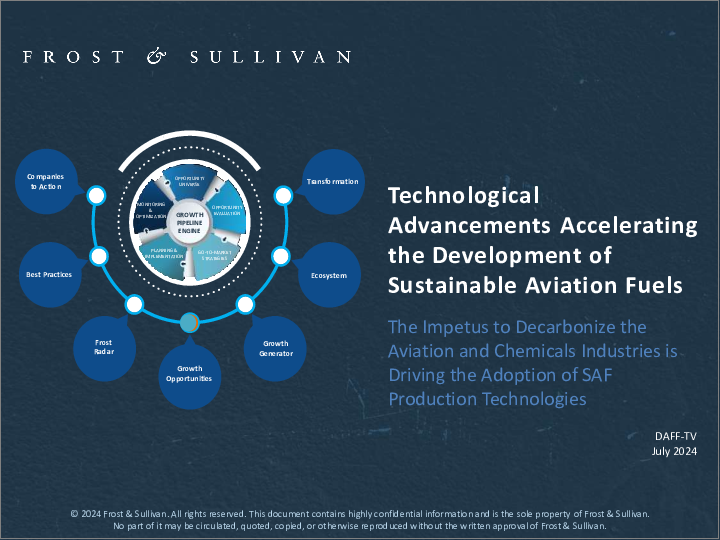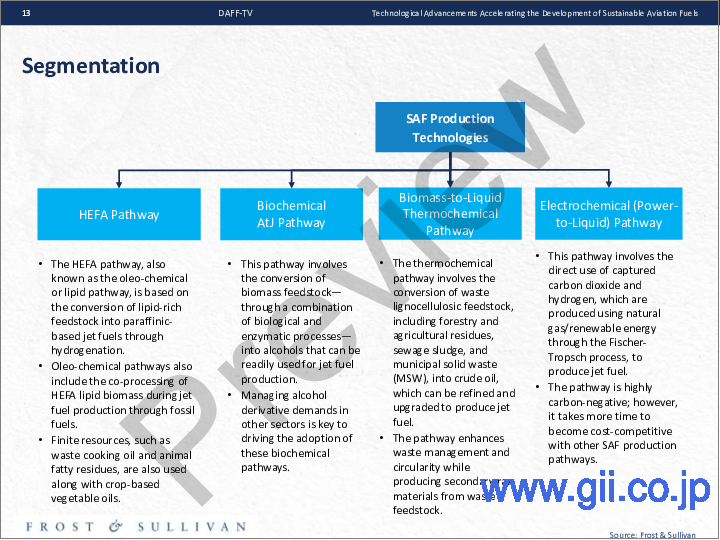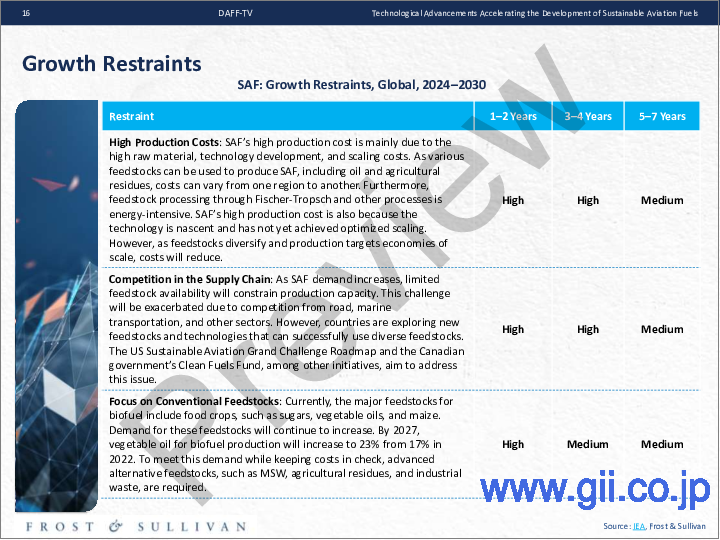|
|
市場調査レポート
商品コード
1532319
持続可能な航空燃料(SAF)の開発を加速する技術の進歩Technological Advancements Accelerating the Development of Sustainable Aviation Fuels |
||||||
|
|||||||
| 持続可能な航空燃料(SAF)の開発を加速する技術の進歩 |
|
出版日: 2024年07月17日
発行: Frost & Sullivan
ページ情報: 英文 45 Pages
納期: 即日から翌営業日
|
- 全表示
- 概要
- 目次
航空業界と化学業界の脱炭素化がSAF生産技術の導入を促進
国際エネルギー機関(IEA)によると、航空業界は世界の炭素排出量の2%を占めています。2022年の累積排出量は約8億トンに達し、2050年には累積排出量が約17億5,000万トンから20億トンに達すると予想されています。国際航空運送協会(IATA)は、2050年までにFly Net Zeroを達成することを公約しており、この目標を達成するための戦略は、SAFの生産に依存し、排出源での排出排除と炭素回収によるオフセットを組み合わせることで主に達成されます。このように、航空業界では、徹底的な脱炭素化を達成することが急務となっています。
航空業界の環境フットプリントを大幅に削減し、ジェット燃料生産における化石燃料への依存を減らすために、SAF設備の大規模展開が今、求められています。SAF生産の増加は、硫黄酸化物や窒素酸化物などの大気汚染物質が大気中に直接放出されなくなり、ライフサイクルベースで特定の温室効果ガス排出量の大幅な削減につながります。したがって、SAF生産技術は、航空業界における大規模な排出削減を可能にする大きな可能性を秘めています。
大規模なSAF生産施設の世界的な展開を加速するには、いくつかの地域的イニシアティブと有利な政策規制が必要です。航空業界はまた、航空機エンジン設計における未来のイノベーションの利用を計画しており、これにより長期的にはエンジンを100%SAFで駆動することが可能になります。
目次
戦略的インペラティブ
- なぜ成長が難しくなっているのか?
- The Strategic Imperative 8(TM)
- 持続可能な航空燃料業界に対する主要な戦略的インペラティブの影響
- Growth Pipeline Engine(TM)を促進する成長機会
- 調査手法
成長機会分析
- 分析範囲
- SAFバリューチェーン
- セグメンテーション
成長ジェネレーター
- 成長促進要因
- 成長抑制要因
技術スナップショット
- AtJパスウェイ
- HEFAパスウェイ
- フィッシャー・トロプシュ合成(FTS)
- 直接液化
- 各種パスウェイにおける原料仕様の比較分析
- SAFパスウェイの技術経済分析
企業と大学のエコシステム
- 水素化脱酸素を用いた大規模なSAF生産
- 高速熱分解油をSAFに変換する独自技術
- SAF研究を推進する主要企業と大学
主な資金調達イニシアティブと特許状況
- 先進市場が資金調達エコシステムを独占
- 米国がSAF特許の大半を占める
成長機会ユニバース
- 成長機会1:100%SAFブレンド
- 成長機会2:ハイブリッド電気SAF推進
- 成長機会3:藻類ベースの大規模SAF生産のための低エネルギープロセス
付録
次のステップ
The Impetus to Decarbonize the Aviation and Chemicals Industries is Driving the Adoption of SAF Production Technologies
According to the International Energy Agency (IEA), the aviation industry accounts for 2% of global carbon emissions. Total cumulative emissions reached approximately 800 million tons in 2022, and cumulative emissions are expected to reach approximately 1,750-2,000 million tons by 2050. The International Air Transport Association (IATA) has committed to achieving Fly Net Zero by 2050, and the strategy to reach this target will be predominantly achieved by relying on SAF production and combining emission elimination at source, as well as offsetting through carbon capture. Thus, there is an urgency to achieve deep decarbonization in the aviation industry.
The large-scale deployment of SAF facilities is the need of the hour to significantly reduce aviation's environmental footprint and lower dependency on fossil fuels for jet fuel production. Increasing SAF production leads to a substantial reduction of specific greenhouse gas emissions on a life cycle basis while ensuring that air pollutants, such as oxides of sulfur and nitrogen, are not directly emitted into the atmosphere. Thus, SAF production technologies hold significant potential to enable large-scale emissions reduction in the aviation industry.
Several regional initiatives and favorable policy regulations are required to accelerate the deployment of large-scale SAF production facilities globally. The aviation industry also plans to use futuristic innovations in aircraft engine design, which will enable engines to be powered by 100% SAF in the long term.
This study covers the following topics: Overview of SAF production technologies Evaluation of growth drivers and restraints for the SAF production technology landscape Analysis of major stakeholders and their innovations in the SAF production technology landscape Techno-economic analysis of SAF production technologies enabling significant emission reductions Overview of the patent landscape and growth opportunities enabling SAF production technologies
Table of Contents
Strategic Imperatives
- Why Is It Increasingly Difficult to Grow?
- The Strategic Imperative 8™
- The Impact of the Top 3 Strategic Imperatives on the Sustainable Aviation Fuels Industry
- Growth Opportunities Fuel the Growth Pipeline Engine™
- Research Methodology
Growth Opportunity Analysis
- Scope of Analysis
- SAF Value Chain
- Segmentation
Growth Generator
- Growth Drivers
- Growth Restraints
Technology Snapshot
- AtJ Pathway
- HEFA Pathway
- Fischer-Tropsch Synthesis (FTS)
- Direct Liquefaction
- Comparative Analysis of Feedstock Specifications in Various Pathways
- Techno-economic Analysis of SAF Pathways
Company and University Ecosystem
- Large-scale SAF Manufacturing Using Hydrodeoxygenation
- Proprietary Technology to Convert Fast Pyrolysis Oil to SAF
- Key Companies and Universities Driving SAF Research
Key Funding Initiatives and Patent Landscape
- Developed Markets Dominate the Funding Ecosystem
- The United States Holds the Majority Share in the SAF Patent Landscape
Growth Opportunity Universe
- Growth Opportunity 1: 100% SAF Blending
- Growth Opportunity 2: Hybrid Electric SAF Propulsion
- Growth Opportunity 3: Low-energy Process for Large-scale Algal-based SAF Production
Appendix
- Technology Readiness Levels (TRL): Explanation
Next Steps
- Benefits and Impacts of Growth Opportunities
- Next Steps
- Take the Next Step
- Legal Disclaimer






